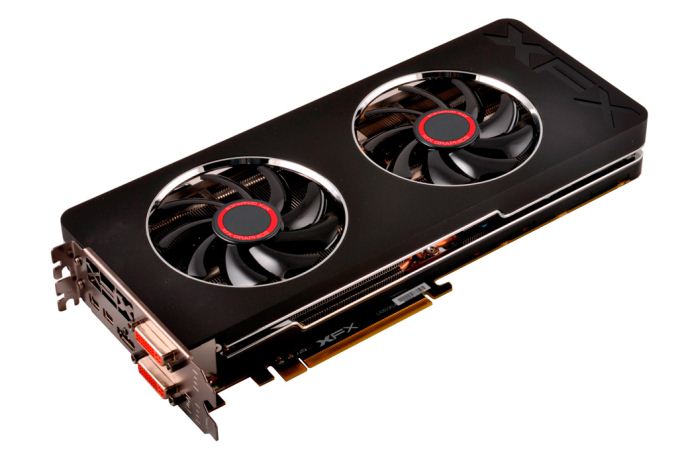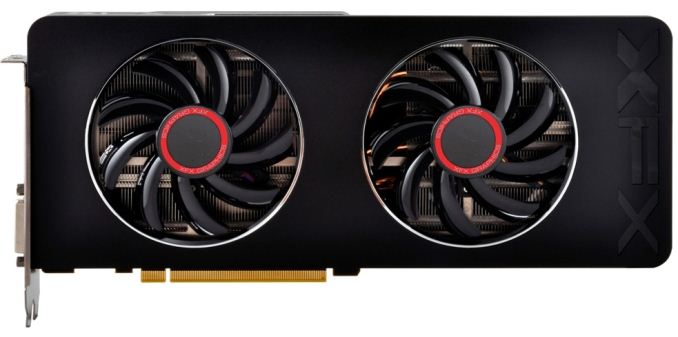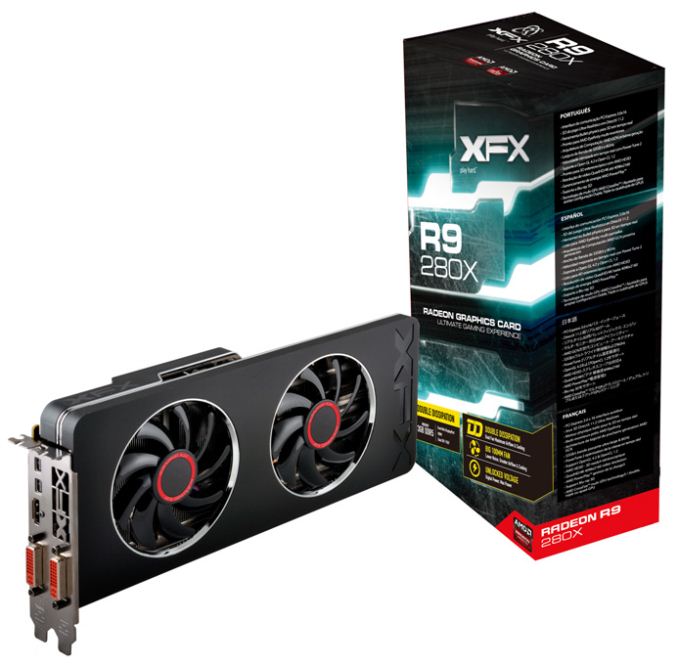The Radeon R9 280X Review: Feat. Asus & XFX - Meet The Radeon 200 Series
by Ryan Smith on October 8, 2013 12:01 AM ESTXFX Radeon R9 280X Double Dissipation
The first of our R9 280X cards is our reference-like sample, XFX’s Radeon R9 280X Double Dissipation. The R9 280X DD is XFX’s sole take on the 280X, utilizing a new and apparently significantly revised version of XFX’s Double Dissipation cooler, and paired with a 280X operating at the 280X’s reference clocks of 850MHz core, 1000MHz boost, and 6GHz RAM. Since there isn’t an overclock here, XFX will primarily be riding on their cooler, build quality, and other value add features.
Diving right into the design of the card, the R9 280X DD is a fairly traditional open air cooler design, as is common for cards in this power and price range. This basic design is very effective in moving large amounts of heat for relatively little noise, making the usual tradeoff of moving some of the cooling workload onto the system’s chassis (and its larger, slower fans) rather than doing the work entirely on its own.
In XFX’s case this is a new design, having forgone their older Double Dissipation design that we first saw on their 7970BEDD back in 2012. What’s changed? Without going into minute details, practically everything. At first glance you’re unlikely to even recognize this as an XFX card due to the fact that this is the first such product from XFX using this design, which aesthetically looks almost nothing like their old design.
First and foremost XFX has gone for the oversized cooler approach, something that’s become increasingly common as of late, equipping the card with one of the larger coolers we’ve ever seen. At 100mm in diameter the two fans on XFX’s design are among the biggest we’ve ever seen, pushing the card to just over 11.1 inches long while causing the heatsink and shroud to stand about 0.75” taller than the board itself.
Drilling down, XFX is using a two segment heatsink, the combined length of which runs the complete length of the card. Providing heat conduction between the GPU and the heatsink is a set of 6 copper heatpipes mounted into a copper base plate. 4 of these heatpipes run towords the rear of the card and the other 2 to the front, perpendicular to XFX’s vertical fin heatsink. Meanwhile cooling for the various discrete components on the board, including the memory, is provided by a separate cut-out baseplate that covers most of the card. There isn’t any kind of connection between the baseplate and the heatsink proper, so it’s the baseplate and any airflow over it that’s providing cooling for the MOSFETs it covers.
Moving on to XFX board, it looks like XFX isn’t doing anything particularly exotic here. XFX is using their standard Duratec high-end components, which includes using solid caps and chokes (typical for all cards in this power category) along with their IP-5X dust free fan. A quick component count has us counting 7 power phases, which would be the reference amount for a 280X, meaning we’re looking at 5 phases for the GPU, and another 2 phases for the memory and I/O.
Meanwhile for I/O XFX implements the common Radeon display I/O configuration of 2x DL-DVI, 1x HDMI, and 2x Mini DisplayPort 1.2. All the while external power delivery is provided by a set of 6pn + 8pin power connectors, as to be expected for a 250W card. With that in mind XFX’s design should have at least some overclocking headroom, but XFX doesn’t provide any overclocking software so you’ll need to stick with Catalyst Overdrive or 3rd party utilities such as MSI Afterburner.
Finally, as a Double Dissipation product the 280X DD is covered by XFX’s lifetime warranty policy, contingent on registering the card within 30 days of purchase. Interestingly XFX remains one of the few board partners that still offers any kind of lifetime warranty, making them fairly exceptional in that regard. As for pricing we’re listing the XFX card at $329 at the moment, though there is still some confusion over whether that’s the final price or not as our XFX rep seemed unsure of that. As is sometimes the case in this industry, we get the impression that they were waiting to see what other manufacturers were going to charge, in which case we suspect the actual launch price will be lower than that. We’ll update this article once we have final pricing information available.













151 Comments
View All Comments
Wreckage - Tuesday, October 8, 2013 - link
I did not see these on Newegg yet. Did AMD actually rebrand a card twice and paper launch it twice???Will Robinson - Tuesday, October 8, 2013 - link
That "rebrand" just kicked the crap out of NVDA's GTX770 for $100 less.Read it and weep.
Wreckage - Tuesday, October 8, 2013 - link
At least you can buy a 770 right now. I suppose you could print out a 280 and tape it to the side of your computer. Wake me when they can beat the GK110.rtsurfer - Tuesday, October 8, 2013 - link
If you had bothered to read the article you would have known that these cards are launching this week.Also,your beloved GK110 will be dealt with by R9 290X. I think you'll have to wait till October 15th for that news,as that is when the NDA expires.
colonelclaw - Tuesday, October 8, 2013 - link
Blimey, some people here are never happy. This card is basically a 770 but $100 cheaper. You know what that means? Nvidia will soon be dropping the price of the 770 and hopefully the 780 too - great news all round.Stop whining about 'rebadging' etc, the only thing that matters to 95% of gamers is the relationship between price and framerates.
Da W - Tuesday, October 8, 2013 - link
Precisely. I don't get fanboïsm. I'm gonna run 3600X1920 with full detail at an afordable price before christmas, be it with a 780 or a 290X. Of course 3 screens works better on AMD, i might be willing to pay a premium.gobaers - Tuesday, October 8, 2013 - link
Add a Z axis for power consumption / noise (two sides of the same coin). I'd take a small hit in framerate for a cooler or quieter card.stefstef - Tuesday, October 8, 2013 - link
looks like the 260 is going to replace the 7790 cards. now you get for the price the 7790 cards were introduced the 260. the 7790 prices dropped. now i wonder if i replace my 6670 for my 720p monitor with the rather cheap 7790 or get the new 260.Will Robinson - Tuesday, October 8, 2013 - link
R9 280X looks very good at $300....the improvements in noise and heat output are commendable.I'll be interested to see how it performs in BF4 after the Mantle API update.
It looks very strong in BF4 beta already.
http://techreport.com/review/25466/amd-radeon-r9-2...
nathanddrews - Tuesday, October 8, 2013 - link
Hmm, I think I'll wait for the next rebadge (re-rebadge) at 20nm. Maybe by summer they'll shrink and add the audio enhancements to the whole lineup. I'm happy for the MSRP price being $299, it should force the 7970GE to under that.If anything, I'm hoping that AMD's new lineup forces NVIDIA to stop overcharging for their products. I know that the market drives pricing, but if price scaled with performance, that means that the GTX700 should be $300 and the GTX780 should be about $350? Not that it will happen like that... but the 780 should not be over $400.